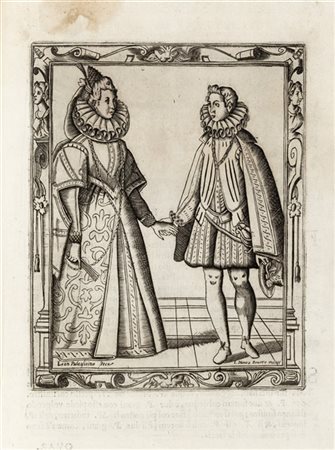 Il Ponte Casa d'Aste - Palazzo Crivelli - Via Pontaccio 12, 20121 Milano
Il Ponte Casa d'Aste - Palazzo Crivelli - Via Pontaccio 12, 20121 Milano
LIBRI E MANOSCRITTI I TORNATA : LIBRI E MANOSCRITTI
martedì 21 gennaio 2020 ore 15:00 (UTC +01:00)
NEGRI, Cesare Milanese (1535-1605) - Le Gratie d'Amore. [Milano: P.Pontio e G.B
NEGRI, Cesare Milanese (1535-1605) - Le Gratie d'Amore. [Milano: P.Pontio e G.B.Piccaglia, 1602?].
Copia da studio, probabilmente in prima edizione, del primo trattato illustrato di danza, composto da Cesare Negri detto "il trombone". Negri fu organizzatore e interprete in feste ed eventi delle più importanti famiglie europee, si esibì addirittura per don Giovanni d'Austria al banchetto offerto da Andrea Doria a Genova prima che questi si imbarcassero per raggiungere la flotta a Lepanto. L'opera è divisa in tre parti, nella prima si elencano celebri danzatori e i loro committenti. La seconda è dedicata alla "gagliarda" che Negri illustra minuziosamente in tutti i suoi passi e variazioni. La terza parte illustra una serie di altri balli minori. Il trattato è forse la fonte più importante per la conoscenza della danza nella seconda metà del XVI secolo. (La seconda edizione del 1604 è una riproduzione della prima con il frontespizio variato, la copia presente presenta alla carta q1 la correzione a stampa applicata con il capilettera della prima edizione).
4to (300 x 210mm). Ritratto dell'autore in facsimile su carta antica, 58 tavole nel testo (manca il quaderno *, contenente frontespizio, dedica a Filippo II e ritratto dell'autore, gore d'acqua e macchie, restauri nel testo con reintegrazioni, mancanze più gravi al margine superiore delle ultime due carte di indice). Legatura del tardo XIX inizio XX in mezza pergamena con titolo su tassello al dorso.
-EN
NEGRI, Cesare Milanese (1535-1605) - Le Gratie d'Amore. [Milan: P.Pontio e G.B.Piccaglia, 1602?].
A study copy, probably the first edition, of the first illustrated dance treatise, composed by Cesare Negri called "the trombone". Negri was a performer and event coreographer for the most important European families. He even performed for Don Giovanni of Austria at the banquet offered by Andrea Doria in Genoa before they embarked to reach the Holy League fleet in Lepanto. The work is divided into three parts, the first listing famous dancers and their patrons; the second dedicated to the "gagliarda" that Negri minutely illustrates in all its steps and variations; the third llustrates a series of other minor dances. The work is perhaps the most important source for the knowledge of dance in the second half of the 16th-century. (The second edition of 1604 is a reproduction of the first with the varied title page, the present copy presents on paper q1 the printed correction applied with the initial letter of the first edition).
4to (300 x 210mm). Author portrait printed in facsimile on old paper, 58 illustrations in text (lacking gathering *, including titlepage and dedication letter to Philip II, waterstaining and spottings, some restaurations in text with paper supplied, more important losses to the superior margins of last two leaf of index). Late XIX-century half vellum with title on spine label.

